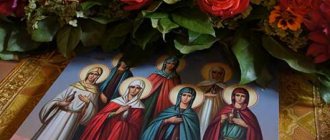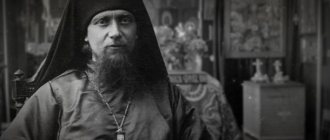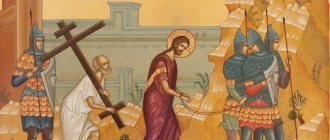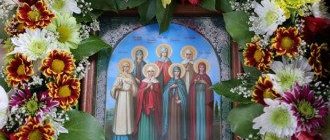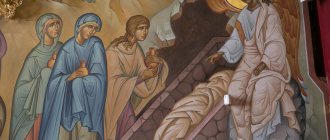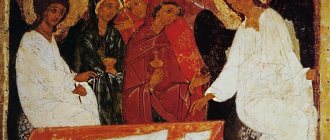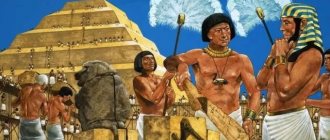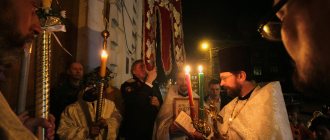| Holy Myrrh-Bearing Women at the Holy Sepulcher |
Sunday of the Holy Myrrh-Bearing Women: Mary Magdalene, Mary of Cleopas, Salome, Joanna, Martha and Mary, Susanna and others;
righteous Joseph of Arimathea and Nicodemus (the abbreviated name used in liturgical books and calendars: “
The Week of the Myrrh-Bearing Women
”) is a church holiday celebrated on the third week (Sunday) of Easter, dedicated to the memory of the saints who witnessed the death, burial and Resurrection of Christ the Savior and those who served Him. The holy myrrh-bearing women accompanied the Lord during His earthly life, served Him from their estates, with their own means, and were with the Lord at Golgotha, at the Lord’s removal from the Cross and at His burial. They hurried to the Tomb the next morning and were the first to learn about the Resurrection of Christ.
On this day, the memory of the righteous rich people of the New Testament, Joseph of Arimathea and Nicodemus, who removed the Body of the Lord from the Cross is also celebrated. Joseph of Arimathea gave the Lord his own coffin, and Nicodemus brought Him aloe for anointing. The courageous decisions of Joseph and Nicodemus, who buried Christ under the watchful eye of the Pharisees, provide Christians with an example of determination in standing for the truth even among those who crucified Christ. In addition, with these witnesses the Church indicates the factual truth of the burial: there were clear eyewitnesses, the burial was documented with the seal of Caiaphas, the seal of the Sanhedrin.
It is no coincidence that the memory of the Myrrh-Bearing Women is celebrated in the third week of Easter: it points to the truth of the Resurrection after the second week of Easter, in which blessed Fomino’s unbelief is remembered.
According to Bishop Methodius (Kulman) of Campania, like the holy myrrh-bearing women and saints Joseph and Nicodemus, all those who serve the Lord, His Body - the Holy Church, act like the holy myrrh-bearing women, and some with their labors and talents: “Do those who sing feel this? Do they understand that they serve the Lord by singing, bringing myrrh to Him, and standing in line with the Myrrh-Bearing Women? Do all church workers and donors feel Whom they serve and Whom they make their sacrifices to?”
Every woman is called to become a myrrh-bearer in life: to maintain peace in her family, to be a helper and support to her husband, to show sacrificial love through the birth and upbringing of children, and through all this to save her soul for eternal life with God.
Third week of Easter
The 3rd Sunday after Easter is called the Week of the Myrrh-Bearing Women. On this day, the Church remembers the women who stood at the cross of Jesus, participated in His burial, and on the first day of Saturday, early in the morning, came to the tomb with myrrh and aromas to anoint the body of the Savior (see: Mark 15, 43–16, 8 ). I also remember Joseph of Arimathea, who performed the burial of Christ. Some chants of this day are borrowed from the services of Holy Week and are dedicated to the last hours of earthly life, death and burial of the Savior.
In particular, at Matins, the Easter stichera are supplemented with the chant “You are clothed with light” from the burial rite performed in the evening of Great Friday:
| Wearing you with light, like a robe, Joseph fell from the tree with Nicodemus and, seeing the dead naked woman unburied, let us accept the compassionate cry, sobbing, saying: Alas for me, Sweetest Jesus! The sun hung in the distance on the Cross, having seen it covered with darkness, and the earth shook with fear, and the church curtain was torn: but now I see Thee, for my sake death has risen by will. How shall I bury Thee, my God, or with what shroud shall I wrap myself? With which hand will I touch Your incorruptible Body? Or will I sing songs about Your exodus, O Generous One? I magnify Your Passion, I sing hymns and Your burial with the Resurrection, calling: Lord, glory to You. | Joseph, clothed with light as a garment, took you down from the Tree (that is, from the Cross) with Nicodemus, and seeing you dead, naked, unburied, beginning a funeral lament in deep compassion, crying out with sobs: “Woe is me, Sweetest Jesus! He Whom he had recently seen hanging on the Cross, the sun was enveloped in darkness, and the earth shook with fear, and the veil of the temple was torn. But now, I see You, for my sake, willingly accepting death. How will I bury You, my God, or as with linen? And with what hands will I touch Your incorruptible body? Or what songs will I sing for the sake of Your death, Merciful One? I glorify Your sufferings, I also sing Your burial with the resurrection, exclaiming: Lord, glory to You!” |
The troparion “Blessed Joseph, I took down Your most pure body from the tree” is also sung:
| Noble Joseph, I took down Your Most Pure Body from the Tree, wrapped it in a clean shroud, and covered it with stinks, and laid it in a new tomb. | Noble Joseph, having taken down Your most pure body from the tree, wrapped it in clean linen and anointed it with incense, and placed it in a new tomb. |
However, an Easter ending is added to it: “But three days ago you rose again, O God, granting great mercy to the world.”
The services of the next three weeks of Easter are thematically connected with passages from the Gospel of John, read these days during the Divine Liturgy.
Source: Metropolitan Hilarion of Volokolamsk, “Orthodoxy”.
Week three. Mironositskaya, May 3 – May 9. Faithful disciples and secret disciples
Estimated reading time: 3 minutes.
The third week of Easter, Myrrh-Bearing Week, as our ancestors called it, opens with the Day of Myrrh-Bearing Women. In recent years, it has been considered - half jokingly, half seriously - a kind of analogue of March 8th, “secular Women’s Day”. It is therefore doubly curious that this holiday is dedicated not only to wives, but also to two husbands - the secret disciples of Jesus Christ, who came to listen to Him under the cover of darkness. These are Joseph of Arimathea and Nicodemus, who participated in the burial of the Lord. Both were members of the Sanhedrin, but, of course, they did not participate in the trial of Christ. Even before His condemnation, Nicodemus tried to defend his Teacher, saying: Does our law judge a person unless they first listen to him and find out what he is doing? (John 7:50). But they did not listen to his words.
After the Crucifixion, Nicodemus and Joseph no longer began to hide: Joseph dared to come to Pilate and ask to give him the body of the deceased Teacher. Having received this permission, together with Nicodemus they removed the body of the Savior from the instrument of painful execution and transferred it to the Garden of Gethsemane, to the tomb that Joseph had once prepared for himself. It’s hard to believe, but these details of His burial were predicted by the prophet Isaiah, who lived in the 8th century BC: He was assigned a grave with evildoers, but He was buried with a rich man, because He committed no sin, and there was no lying in His mouth (Isaiah 53 :9).
Moreover, one must understand that the coffin in the ancient Jewish tradition had nothing in common with four boards and a lid: they were buried in natural or artificially carved caves and the entrance hole, usually very small, was closed with a large stone.
In the rush of Good Friday, when they hurried to kill the crucified and take them down from the crosses for the sake of observing the day of rest, the Sabbath (in Hebrew - “Sabbath”, the last day of the week), Joseph and Nicodemus only managed to beg Pilate’s permission to take and place His wounded body in the tomb Body. According to the testimony of the Evangelist John, Nicodemus brought fragrant oils with which they soaked the burial shrouds, wrapped them around Christ and placed him in the tomb until the first day of the week (Sunday).
A terrible, hopeless, devastating Saturday passed in inaction... And early at dawn several women went to fulfill their last duty to the Teacher - according to tradition, to anoint the body with fragrant oils (perhaps in the bustle of Friday they did not know that Nicodemus had already done this). The evangelists describing this episode do not give us an exact list of those who carried the ointment for the Lord. All four unanimously mention Mary Magdalene among them. Evangelist Mark names among the myrrh-bearers Salome (the mother of the apostles James and John, the sons of Zebedee) and Mary of Jacob (the mother of James, one of the seventy apostles. It was even believed that the Mother of God herself was named this way). Evangelist Luke adds to this list Joanna (the wife of Chuza, one of the officials at the court of the ruler of Galilee, Herod Antipas) and writes: and others with them. The tradition of the Church says that among the “others” were the sisters Martha and Mary (their brother, Lazarus, Christ raised from the dead just before His suffering), Mary of Cleopas and Susanna.
The Gospel is silent about how the apostles of Christ spent that Saturday after the Crucifixion, does not say where they were early on Sunday morning and why the myrrh-bearing women did not turn to them for help. Evangelist Mark gives us meager words about them, “weeping and lamenting” (Mark 16:10). And indeed, it is difficult to imagine the degree of this torment and confusion... But in the midst of unbearable pain and the collapse of all hopes, several women, without stumbling over the arguments of the mind, walked from the heart at dawn to the tomb.
But what next? Who will roll away the stone from the door of the tomb for us?.. The details of the events differ somewhat among the evangelists, but it is known exactly what greeted the myrrh-bearing women in the garden of Gethsemane: a heavy stone lies to the side, the tomb is empty, and only the shrouds and cloth covering the head, folded separately , at the burial site.
The women’s first guesses: “The body was stolen and taken away!” But the myrrh-bearing women were delivered from these doubts by the appearance of an angel. The evangelist says that his appearance was like lightning. And the words he said were no less striking than his appearance: “Why are you looking for the living among the dead? He's not here. He has risen and is going before you to Galilee!” And so, with a mixture of joy and fear, the Lord’s disciples run with this news to the apostles...
Optina Pustyn
Today the Holy Church remembers those who remained faithful to the end. Those who were not stopped by death. Those whose love flared up even stronger after the death of Christ!
Righteous Nicodemus, a Pharisee, member of the Sanhedrin, became a secret disciple of Christ. It was he who came to Christ in the dead of night to hear the words of Eternal Life about being born again. This is what he fearlessly said to the Jews when they were angrily seeking accusations against the Lord in order to kill Him: “Does our law judge a man before it hears him?”
(John 7:51) The Holy Apostle and Evangelist John the Theologian says that after removing the body of the Lord from the Cross, he
“brought a composition of myrrh and aloes, about a hundred liters”
(John 19:39).
Righteous Joseph came from the Palestinian city of Arimathea and was also a secret disciple of Christ. He was an honorary member of the Sanhedrin, but did not participate in “council and action”
Jews who passed the death sentence on Christ.
He dared, without fear, to ask for the body of Christ. Evangelist Mark says: “Pilate was surprised that He had already died, and, calling the centurion, asked him how long ago He had died?
And having learned from the centurion, he gave the body to Joseph” (Mark 15:44–45).
Every day at the Liturgy after the Great Entrance, the priest reads the troparion at the altar: “Blessed Joseph took down Your Most Pure Body from the tree, wrapped it in a clean shroud and covered it with fragrant scents, and laid it in a new tomb.”
Evangelist Matthew emphasizes that he gave the Lord a tomb hewn out of the rock, which he had prepared for himself:
“Taking the body, Joseph wrapped it in a clean shroud and laid it in his new tomb, which he had hewn out of the rock”
(Matthew 27:59-60) .
Some of the Jews hated Joseph terribly, and they swore an oath to kill the righteous man. He had to leave his native place. So he ended up in Britain, a remote corner of the Roman Empire, where he preached the word of God. There he rested.
Very little is said about the myrrh-bearing women on the gospel pages. And in this little - the most important thing: loyalty and love. “I stood at the cross of Jesus His Mother, and His Mother’s sister, Mary of Cleophas, and Mary Magdalene”
(John 19:25).
«And then,
– writes the Evangelist Matthew, “
all the disciples left Him and fled ”
(Matthew 26:56). The Apostle Peter denied Him three times. Judas betrayed. The Garden of Gethsemane was filled with drowsiness... A terrible moment of testing devotion and love begins at the Cross!
The myrrh-bearers remained at the Cross simply because they LOVE! They did not hide, did not run away, just as they do not run away from the sun. They did not lose heart because in front of them on the Cross was the most important thing - the Truth itself! “The weakest sex then appeared the most courageous: so everything changed!” - exclaims St. John Chrysostom.
Christ did not reveal to them, as He revealed to the apostles, the secrets of His death and His coming Resurrection. But they understood in their hearts that on the Cross was the crucified Truth, which would soon become an immortal Victory! And then, after Saturday, at the dawn of the third day, they, these weak vessels, with the vessels of the world, made their way through the darkness to anoint the body of the Teacher... And it was to them that the Risen Christ appeared first! They were the first to hear from the Lord: “Rejoice!” – which has become the essence of the Christian faith. “Always rejoice. Pray without ceasing. Give thanks for everything"
(1 Thess. 5:16–18).
And we, people of the 21st century, really need this reminder of love, sensitivity, and simple human fidelity! Humanity really lacks these qualities! Elder Sophrony (Sakharov) says that “we are now surrounded by an “arctic ocean” of a prayerless world, and if we ourselves do not carry within ourselves such a power of fire that defeats the “cosmic” cold, then we will inevitably perish along with this world!”
It's very cold in the world right now! Therefore, the small heart lamp of each of us should not go out. Its fire is love! Oil and wick – courage and loyalty! St. Justin of Serbia exclaims: “Everything human is a curse, hell, until it is transformed into the Divine-Human. With the God-man Christ, everything human becomes paradise, paradise, paradise. And there is no limit to your joy, man, because you are a man, for only through Him and in Him do you feel that you are an eternal man, a heavenly man, a cherubic man, a God-faced man. It is torment, all torment, O my mortal brothers and brothers, to be a man without the God-man Christ; and the joy and all-joy of being a man with the God-man Christ!”
And the holy righteous John of Kronstadt reminds: “A Christian, with the help of the grace of the Risen Christ, himself internally rises from the dead and becomes a living person in spirit, and receives the joyful hope of a blessed resurrection on the last day of the world by the Holy Spirit!” These words contain the most important thing, the very essence, the core of our spiritual work - to internally rise from the dead and become a living person in spirit while still here on earth. It is very difficult to become alive! It's easier to be dead. Convenient. More practical. Don't strive for anything. Don't desire any grace. From the sofa to the TV. From the kitchen to the Internet.
Or, on the contrary, fill your life to the limit with fictitious worries, unnecessary running around, chasing after earthly ghosts. There is not a free second, but everything is in vain! The Venerable Nektarios of Optina, whose memory we celebrate today, said to those who came to him: “Man was given life so that it could serve him, and not he should serve it! In serving life, a person loses proportionality, works without prudence and comes into very sad bewilderment: he doesn’t even know why he lives!” To serve life means to serve your passions, to live only by the earth. This is when a person does not carry Heaven in his heart, but only the joyless, sour, deadening everyday life! This is when there is no desire to stand at the Crucified Christ, when you do not want to go early in the morning to the Risen Savior.
Civilizations were born and died. Bloody wars swept away millions of human lives along the way. Fashions, tastes, and ideologies changed. But human loyalty has never lost its value! Devotion to Christ has never become an empty phrase! When Mary poured precious myrrh on the head of Christ, the disciples were indignant: why such a waste? And the Lord stopped them: “Why are you embarrassing the woman? She did a good deed for Me... Wherever this Gospel is preached in the whole world, it will be said in memory of her what she did.”
(Matt. 26:10–13).
And each of us is not only “the green morning of the Sabbath”
(Mark 16:2), but also throughout his life he must go in search of Christ! To the life-giving Tomb! To the Risen Savior of the world! Carrying the scents of the heart!
Russian myrrh-bearers - white handkerchiefs - begged for the victory of our people in the Patriotic War. And when, at some international forum, journalists after the war asked our hierarch: “What will happen to the Russian Church when the last grandmothers die?” “He replied: “Our grandmothers are immortal!”
Through the twilight of life, when it will be difficult and almost impossible to bear sorrows and temptations, let us ask God to help us maintain loyalty and devotion - to our Fatherland, to those close and dear people who are nearby, to the Church and Christ! “And in everything,” as St. Nektary of Optina said, “we will look for great meaning!”
Hegumen Tikhon (Borisov)
May 12, 2022
Russian Orthodox Church
print version
3rd Sunday of Easter, Holy Myrrh-Bearing Women.
Calendar notes:
From this day on all Sundays until the celebration of Easter at Matins, the canon of the holiday is preceded by the singing of the Easter canon with the Mother of God (without choruses on the 9th song).
Order of readings, according to the calendar:
Morning. – Ev. 3rd, Mark, 71 credits, XVI, 9–20.Lit. – Acts, 16 ch., VI, 1–7.
Mk., 69 credits, XV, 43 – XVI, 828.
3. 3rd Sunday after Easter, Holy Myrrh-Bearing Women. Voice 2. St. Theodosius, abbot of Kiev-Pechersk.
Mchch. Timothy and the Moors. Pechersk-Not Made by Hands and Svenskaya-Pechersk Icons of the Mother of God. Icon of the Mother of God, called “Svenskaya-Pecherskaya”
[18].
Prpp. Juliania and Eupraxia of Moscow. Right Martha and Mary, sisters of rights. Lazarus[19]. Blgv. Tamara, Queen of Georgia (rolling celebration during the Week of the Myrrh-Bearers)[20].
Note.
In the Church of the Holy Myrrh-Bearing Women, the service (small and great vespers, matins and Liturgy) is in every way similar to the service of the Great Martyr. George, only at Vespers the parimations from the Sunday of All Saints are read, at Matins the polyeleos are magnified: “We magnify you, holy myrrh-bearers, and honor your holy memory, for you pray for us to Christ our God.” Selected Psalm: “Blessed is the man, fear the Lord...”, and so on (cf.: Typikon, Chapter 50, “3rd Sunday of Passover, the Holy Myrrh-Bearing Women and Joseph the Righteous”, 3rd “behold”).
The service is performed according to Triodion (A).
When performing the polyeleos service[21], St. Theodosius, abbot of the Kiev-Pechersk, one can be guided by the 4th Mark chapter of the Typikon under April 23: “If the memory of the Holy Great Martyr George occurs on the Sunday of the Myrrh-Bearers, or the Paralytic, or the Samaritan Woman,” and the 2nd Mark Chapter of the Typikon under May 8: “It is appropriate know that if Saint John the Theologian happens on the Sunday of the Myrrh-Bearers, or about the paralytic, or the Samaritan woman, or about the blind man” (B).
A. At Great Vespers
“Blessed is the man” - all kathisma.
On “Lord, I cried” the stichera for 10: Sunday, tone 2 – 7, and the holiday (Sunday of the Myrrh-Bearers), the same tone – 3. “Glory” - the holiday, tone 6: “Myrrh-bearing woman, Thy tomb... ", "And now" - dogmatist, voice 2: "Pass away the shadow of the law...".
Entrance. Prokeimenon of the day.
At the litia the stichera of the holiday, tone 1. “Glory” - the holiday, voice 6: “Ask Joseph...”, “And now” - the Resurrection of the Theotokos, the same voice: “My Creator and Savior...” (see in the Triodion on the row).
On the stichera there is the resurrection stichera, tone 2: “Thy Resurrection, O Christ the Savior, enlightens the whole universe...”, and the stichera of Easter, tone 5 (with their refrains). “Glory” - the holiday, the same voice: “To you, clothed with light, like a robe...”, “And now” - Easter, the same voice: “Resurrection day...” (at the end, “Christ is risen from the dead...” is sung once, as the end of a stichera).
According to the Trisagion - “To the Virgin Mary...” (three times).
Note.
“Be aware that from the Sunday of St. Thomas there is no breaking of bread for the blessing of the loaves, for the shortness of the night” (cf.: Typikon, ch. 50, “3rd Sunday after Passover, the holy myrrh-bearing women and Joseph the Righteous,” 2- e "see")
At matins
on “God is the Lord” - Sunday troparion, tone 2: “When you came down...” (twice). “Glory” is the troparion of the holiday, the same voice: “Blessed Joseph...”, “And now” is the troparion of the holiday, the same voice: “To the myrrh-bearing women...”.
Kathismas 2nd and 3rd. Small litanies. Sunday sedals (see in Triodion).
Instead of the polyeleos, one should sing the Immaculate Ones, that is, the 17th kathisma.
Note.
The singing of the Immaculates at Sunday matins is prescribed by the Rule before the celebration of the Exaltation (September 21), except for coinciding with the Sunday of the Polyeleos or Vigil feast. The 118th psalm (17th kathisma) is sung in the 5th tone, regardless of the weekly tone, and immediately after it the troparia “The Council of Angels...”. In parish practice, the polyeleos are usually sung instead of the Immaculates at Sunday all-night vigils.
"Angelic Cathedral..." Ipakoi, voice 2: “Walking through passion...”. Degrees - antiphons of the 2nd voice. Resurrection Prokeimenon, tone 2: “Arise, O Lord my God...”. Sunday Gospel 3rd. “Having seen the Resurrection of Christ...” (three times). According to Psalm 50: “Glory” - “Through the prayers of the apostles...”, “And now” - “Through the prayers of the Mother of God...”. Sunday stichera, tone 6: “Jesus is risen from the grave...”.
Canons: Easter with the Irmos and the Theotokos on 6 (irmos twice) and the canon of the Feast of Triodion (Week of the Myrrh-Bearers) on 8.
Note.
The canon of Easter is sung at Sunday matins on the Sunday of the Myrrh-Bearing Women, the paralytic, the Samaritan and the blind man, with all the troparions and the Theotokos, without the final “Christ is risen from the dead...” for each song and without choruses on the 9th song of the canon.
Bible songs “We sing to the Lord...”.
Easter Catavasia: “Resurrection Day...”
According to the 3rd hymn – the kontakion of Easter, tone 8: “Even if thou didst descend into the grave...”, and Ikos, the same voice: “Even before the sun...”; Sedal of the holiday, voice 2: “The world is warmer...”. “Glory, even now” - the seat of the holiday, the same voice: “The face of Your disciples...”.
According to the 6th hymn - the kontakion of the holiday, voice 2: “Thou hast commanded the myrrh-bearers to rejoice...”, and ikos, the same voice: “On Thy tomb, O Savior...”.
I won’t sing “The Most Honest” for the 9th song. (The usual incense is performed.)
According to the 9th song - “Holy is the Lord our God.” Exapostilary of Easter: “Having fallen asleep in the flesh...” “Glory” is the luminary of the holiday: “Wives, hear...”, “And now” is the same luminary.
“Every breath…” and psalms of praise.
On the praises are the Sunday stichera (see in the Triodion), tone 2 – 8. “Glory” is the gospel stichera, the same voice: “To those who came from the world...”, “And now” - “Most blessed art thou...”.
Note.
The choruses to the last two laudatory stichera are the usual Sunday ones (in the Triodion the incipits of the verses are indicated). Verse 1: “Arise, O Lord my God, that Thy hand may be exalted, / do not forget Thy poor to the end”; Verse 2: “I will confess to You, O Lord, with all my heart, / I will tell of all Your wonders.”
Great doxology. According to the Trisagion - the Sunday troparion: “Risen from the grave...”.
On the clock
- Sunday troparion: “When You came down...” “Glory” is the troparion of the holiday: “Noble Joseph...”. Kontakion of the holiday: “Rejoice in the myrrh-bearers...”
At the Liturgy
blessed voices - 4 (see in Triodion), and the holiday of Triodion (Sunday of the Myrrh-Bearers), hymn 6 - 4.
At the entrance - the Sunday troparion, voice 2: “When you came down...”, the troparion of the holiday, the same voice: “Blessed Joseph...”. “Glory” is the kontakion of the holiday of Triodion, the same voice: “Rejoice in the myrrh-bearers...”, “And now” is the kontakion of Easter, the 8th tone: “Even to the grave...”.
Prokeimenon - Week of the Myrrh-Bearers, tone 6: “Save, O Lord, Thy people...”; verse: “To You, O Lord, I will cry...”
The Apostle and the Gospel - Week of the Myrrh-Bearers.
Alleluia - Week of the Myrrh-Bearers, tone 8: “Thou hast been well pleased, O Lord, with Thy land...”; verse: “Mercy and truth...”
Honorer of Easter.
Participated in – Easter: “Receive the Body of Christ...”, and the day (Sunday): “Praise the Lord from Heaven...”.
B. At Great Vespers
“Blessed is the man” - all kathisma.
On “Lord, I cried” stichera for 10: Sunday, tone 2 - 3, feast (Sunday of the Myrrh-Bearers), the same tone - 3, and the venerable one - 4[22]. “Glory” - the holiday (Sunday of the Myrrh-Bearers), tone 6: “Myrrh-bearing woman of Thy tomb...”, “And now” - dogmatist, tone 2: “Pass the lawful canopy...”.
Entrance. Prokeimenon of the day. Parimia of the monk – 3.
On the litia[23] the stichera of the temple and the stichera of the monk, voice 1 and voice 2 (see on the litia). “Glory” - the venerable one, voice 6: “Hedgehog in the image...” (see on the lithium), “And now” - the holiday (Sunday of the Myrrh-Bearers), the same voice: “Ask Joseph...” (see the glory of lithium stichera Triodion)[24].
On the stichera there is the resurrection stichera, tone 2: “Thy Resurrection, O Christ the Savior, enlightens the whole universe...”, and the stichera of Easter, tone 5 (with their refrains). “Glory” - the venerable one, tone 8: “There are many monks...”, “And now” - the holiday (Sunday of the Myrrh-Bearers), tone 5: “To you, clothed with light, like a robe...” (see the book of verse stichera of the Triodion )[25].
According to the Trisagion - “To the Virgin Mary...” (three times)[26].
Note.
“Be aware that from the Sunday of St. Thomas there is no breaking of bread for the blessing of the loaves, for the shortness of the night” (cf.: Typikon, ch. 50, “3rd Sunday after Passover, the holy myrrh-bearing women and Joseph the Righteous,” 2- e "see")
At matins
on “God is the Lord” - Sunday troparion, voice 2: “When you came down...” (once), troparion of the holiday (Sunday of the Myrrh-Bearers), the same voice: “Blessed Joseph...” (once). “Glory” is the troparion of the saint, tone 8, “And now” is the troparion of the holiday (Sunday of the Myrrh-Bearers), tone 2: “To the myrrh-bearing women...”.
Kathismas 2nd and 3rd. Small litanies. Sunday sedals (see in Triodion).
Polyeleos. The Greatness of the Saint and the Selected Psalm.
Note.
The singing of the Immaculates instead of the polyeleos at Sunday matins is prescribed by the Rule for this Week and on subsequent Sundays until the celebration of the Exaltation (September 21), except for coinciding with the Sunday of the polyeleos or vigil feast. The 118th psalm (17th kathisma) is sung in the 5th tone, regardless of the weekly tone, and immediately after it the troparia “The Council of Angels...”. In parish practice, the polyeleos are usually sung instead of the Immaculates at Sunday all-night vigils.
"Angelic Cathedral..." Ipakoi, voice 2: “Walking through passion...”. Sedalen of the monk according to the 1st verse, tone 4: “To the calling of the Lord...”; The monk’s sedalin according to the 2nd verse, tone 8: “With tearful streams...”. “Glory” is the seat of the monk in polyeleos, the same voice: “From the womb he was sanctified...”, “And now” - Theotokos Menaion, the same voice: “The door of heaven and the ark...” (see May 8, in the service of St. John the Theologian, according to Polyeleos)[27]. Degrees - antiphons of the 2nd voice. Resurrection Prokeimenon, tone 2: “Arise, O Lord my God...”. Sunday Gospel 3rd. “Having seen the Resurrection of Christ...” (three times). According to Psalm 50: “Glory” - “Through the prayers of the apostles...”, “And now” - “Through the prayers of the Mother of God...”. Sunday stichera, tone 6: “Jesus is risen from the grave...”.
Canons: Easter with the Irmos and the Theotokos on 6 (irmos twice), the venerable one on 4 and the Feast of the Triodion (Sunday of the Myrrh-Bearers) on 4.
Note.
The canon of Easter is sung at Sunday matins on the Sunday of the Myrrh-Bearing Women, the paralytic, the Samaritan and the blind man, with all the troparions and the Theotokos, without the final “Christ is risen from the dead...” for each song and without choruses on the 9th song of the canon.
Note.
The canon of the Triodion holiday (composite) is sung in 4 without repetition. First the Sunday troparion (see by content), then the holiday (see by content). “Glory” is Trinity, “And now” is Theotokos (cf.: Typikon, April 23, 4th Markov chapter; May 8, 2nd Markov chapter).
Bible songs “We sing to the Lord...”.
Easter Catavasia: “Resurrection Day...”
According to the 3rd song - kontakion and ikos of the monk, voice 3; Sedal of the Reverend, voice 4th. “Glory” is the sedal of the saint, the same voice, “And now” is the sedal of the feast (Sunday of the Myrrh-Bearers), voice 2.
According to the 6th hymn - the kontakion of the holiday (the Week of the Myrrh-Bearers), voice 2: “Thou hast commanded the Myrrh-Bearers to rejoice...”, and Ikos, the same voice: “On Thy tomb, O Savior...”.
I won’t sing “The Most Honest” for the 9th song. (The usual incense is performed.)
According to the 9th song - “Holy is the Lord our God.” Exapostilary of Easter: “Having fallen asleep in the flesh...” “Glory” is the luminary of the venerable one, “And now” is the luminary of the feast (Sunday of the Myrrh-Bearers): “Wives, hear …”.
“Every breath…” and psalms of praise.
On the praises, stichera for 8: Sunday (see in the Triodion), tone 2 - 4, and the venerable one, tone 2 and tone 6 - 4 (with the hymn and their refrains; see the choruses in the Menaion on the stichera of the evening ). “Glory” is the Gospel stichera, tone 2: “To those who came from the world...” (see in the Triodion), “And now” - “Most blessed art thou...”.
Note.
For the choruses to the last two stichera of praise, see the stichera on the Vespers stichera in the service of the Menaion. Verse 1: “The death of His saints is honorable before the Lord”; Verse 2: “Blessed is the man who fears the Lord, / He will greatly delight in His commandments.”
Great doxology. According to the Trisagion - the Sunday troparion: “Risen from the grave...”.
On the clock
[28] – Sunday troparion, tone 2: “When you descended...”. “Glory” is the troparion of the saint. The kontakia of the holiday (Week of the Myrrh-Bearers): “Rejoice in the Myrrh-Bearers...”, and the venerable one - are read alternately[29].
At the Liturgy
blessed voices - 4 (see in Triodion), the feast of Triodion (Sun of the Myrrh-Bearers), hymn 3 - 4, and the venerable hymn, hymn 6 - 4.
At the entrance - the Sunday troparion, tone 2: “When you came down...”, the troparion of the venerable one. “Glory” is the kontakion of the monk, “And now” is the kontakion of the holiday of Triodion (Week of the Myrrh-Bearers), tone 2: “Rejoice in the Myrrh-Bearers...”.
Prokeimenon - Week of the Myrrh-Bearers, tone 6: “Save, O Lord, Thy people...”, verse: “To Thee, O Lord, I will cry...”; and the venerable one, voice 7: “Honest before the Lord...”.
The Apostle and the Gospel - The Week of the Myrrh-Bearers and the Venerable.
Alleluia - Week of the Myrrh-Bearers, tone 8: “Thou hast been well pleased, O Lord, with Thy land...”; and the venerable one, voice 2: “Your priests will be clothed with righteousness...”.
Honorer of Easter.
Participated – of the day (Sunday): “Praise the Lord from Heaven...”; and the venerable one: “In eternal memory...”.
At a meeting of the Holy Synod of the Russian Orthodox Church on July 15, 2016, the service to the icon of the Mother of God called “Svenskaya-Pecherskaya” was approved and recommended for general church liturgical use. The text of the service is posted on the official website of the Russian Orthodox Church - Patriarchia.ru (https://www.patriarchia.ru/db/text/4562190.html), and on the website of the Publishing House of the Moscow Patriarchate of the Russian Orthodox Church (https://nbt.rop .ru/?q=texts/sluzhba/368). Wed: Minea-May. M., 2002. Part 1. pp. 114–130. See: Menaia-April. M., 2002. Part 2. pp. 339–340. See: Ibid. P. 341. Wed: Typicon, April 23, 5th Markov chapter; May 21, “behold.” A clergyman's handbook. M., 19922. T. 1. P. 106. It is permissible to include the Slavnik, tone 8, among the four stichera of the Menaion: “Come, let us all flock together...”. Wed: Rozanov V. Liturgical Charter of the Orthodox Church. pp. 61–65, 782. In the stichera on the litia and on the stichera on “And now” the chant of the Triodion, i.e., the holiday (the Week of the Myrrh-Bearers) is indicated. In the Triodion it is placed on “Glory” (cf.: Typikon, April 23, 4th Markov chapter; May 8, 2nd Markov chapter; V. Rozanov. Divine Service Charter of the Orthodox Church. P. 683, 685). In the stichera on the stichera on “And now” the chant of the Triodion, i.e., the holiday (the Week of the Myrrh-Bearers) is indicated. In the Triodion it is placed on “Glory” and is sung instead of “Resurrection Day...” (cf.: Typikon, April 23, 4th Mark’s chapter; May 8, 2nd Mark’s chapter; V. Rozanov. Divine Service Charter of the Orthodox Church. P. 683, 685). The saint's troparion is not sung according to the Trisagion (at the blessing of the loaves), since the saint's service is a polyeleos service, and not a vigil. The singing of the Theotokos, and not the hymns of the holiday, is indicated in the 4th Mark chapter of the Typikon under April 23 and in the 2nd Mark chapter of the Typikon under May 8. Wed: Typikon, April 23, 4th Markov chapter; May 8, 2nd Markov chapter; Rozanov V. Liturgical Charter of the Orthodox Church. pp. 684, 685. Compare: Charter. M., 1610. L. 157 vol., 161 vol.; Charter M., 1634. L. 121; Charter M., 1641. L. 614, 638; Rozanov V. Liturgical Charter of the Orthodox Church. pp. 684, 685.
← previous day next day →
Third Sunday of Easter, the Holy Myrrh-Bearing Women: what is important to remember May 3, 2022
In Orthodoxy, our usual Sundays are called weeks. The third Sunday after Easter is traditionally dedicated to the holy myrrh-bearing women. This is a very unusual day, the traditions of which every believer should know about.
Easter celebrations in 2022 do not end with the main celebration on April 19th. The Orthodox Church calendar notes that the celebration lasts 40 days, until the Feast of the Ascension of the Lord. The Day of the Myrrh-Bearing Women is included in this string of days after the celebration of the greatest day for Orthodox people.
Who are the myrrh-bearing women and what is the meaning of this day
As you know, Jesus Christ had faithful apostles, but in many ways his disciples turned out to be even more faithful to him, who followed him when the apostles experienced fear and doubt.
On this day, we remember the events that happened on the eve of Easter. On the third day after the death of Christ, his followers hurried to the tomb to perform the funeral rites that were performed at that time. They carried with them myrrh - oil with which they anointed the dead before burial.
Many disciples were not ready to believe in the resurrection of Christ, including the myrrh-bearing women themselves. They walked to the tomb of the Lord, but did not know that they would not be able to see his body. They were driven by only one thing - love. When they arrived, they saw that the stone of the coffin had been moved away. Inside the cave they were met by an angel who said that the Lord was waiting for them in Galilee. They hurried to the apostles, and on the way back they met Christ. Their joy knew no bounds.
These events show us the pure and bright love that we should all be filled with. A little faith is enough to feel great happiness.
Traditions of the Day of Myrrh-Bearing Women
On May 3, it is important to remember that only kindness and love can save this world from filth, from everything bad and terrible. On this day, try to read prayers of gratitude, do good deeds and meet your loved ones halfway, helping them with business and solving problems.
In Orthodoxy, this day is the day of all women and, especially, mothers. Don't forget to congratulate your mother, sister, grandmother on this great event. Give each other gifts and take care of each other on such an important day. Church workers advise calling relatives or visiting them on this day. They deserve your love and attention.
Memorial prayers are also read in churches on this day. On this day, it is customary to visit the cemetery and remember deceased relatives and loved ones. Of course, in 2022 it is better to do this at home. In general, this is a rather joyful day, because it is associated with the resurrection of Jesus Christ. This is a great event for all believers.
An excellent gift on May 3 for any believing woman would be an icon of the Myrrh-Bearing Women. She will protect your mother, grandmother, spouse or sister from all evil and help keep love in your heart.
(second Sunday after Easter)
On the 3rd Sunday after Easter, the Holy Church remembers the holy myrrh-bearing women and the righteous Joseph of Arimathea and Nicodemus - the secret disciples of Christ. With its divine service, the Church once again places us on Golgotha at the Cross of Christ, from which Joseph and Nicodemus remove His Most Pure Body, and in Vertograd at the tomb, where they lay the Body of Jesus Christ, and where then the myrrh-bearers, who came to anoint the Body with fragrant oils, are the first to be rewarded with seeing the Risen One Gentlemen.
Following the example of the holy myrrh-bearing women, we must kindle in our hearts true self-sacrificing love for our Savior, so that, as the Apostle says (Rom. 8:38-39), nothing can separate us from Him - neither the present, nor the future, nor life, not death, not angels, not men. In addition, just as the holy women, wounded by fierce sorrow at the sight of the crucified Lord, sought and found consolation in His tomb, so every Christian soul should seek consolation in sorrows and sorrows at the tomb and cross of its Savior.
Saint Mary of Clopas
Saint Mary of Cleopas, the myrrh-bearer, according to the tradition of the Church, was the daughter of Righteous Joseph, the Betrothed of the Blessed Virgin Mary (December 26), from her first marriage and was still very young when the Most Holy Virgin Mary was betrothed to Righteous Joseph and introduced into his house. The Holy Virgin Mary lived with the daughter of Righteous Joseph, and they became friends like sisters. Righteous Joseph, upon returning with the Savior and the Mother of God from Egypt to Nazareth, married his daughter to his younger brother Cleopas, therefore she is called Mary Cleopas, that is, the wife of Cleopas. The blessed fruit of that marriage was the holy martyr Simeon, an apostle from the age of 70, a relative of the Lord, the second bishop of the Church of Jerusalem (April 27). The memory of Saint Mary of Cleopas is also celebrated on the 3rd Sunday after Easter, the holy myrrh-bearing women.
Saint Joan the Myrrh-Bearer
Saint Joan the Myrrh-Bearer, the wife of Chuza, the steward of King Herod, was one of the wives who followed the Lord Jesus Christ during His preaching and served Him. Together with other wives, after the Savior's death on the Cross, Saint Joan came to the Tomb to anoint the Holy Body of the Lord with myrrh, and heard from the Angels the joyful news of His glorious Resurrection.
Prayers
Troparion, tone 2
Noble Joseph/ wrapped Your most pure body from the tree,/ entwined a clean shroud,/ and placed it in a new tomb with fragrant fragrances:/ but Thou hast risen for three days, O Lord, // Giver of the worlds and great mercy.
An angel appeared to the myrrh-bearing women at the tomb, crying:/ Peace is fitting for the dead,/ But Christ of corruption appeared a stranger./ But cry: the Lord is risen, // give to the world I have mercy.
Kontakion, tone 2
You commanded the myrrh-bearers to rejoice,/ You quenched the tears of the foremother Eve/ with Your resurrection, O Christ God,/ You commanded Your apostle to preach // The Savior is risen from the grave .
